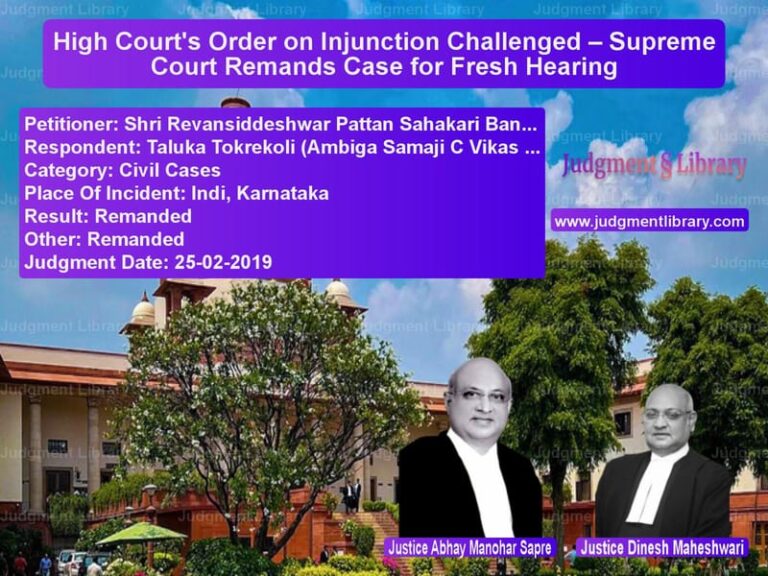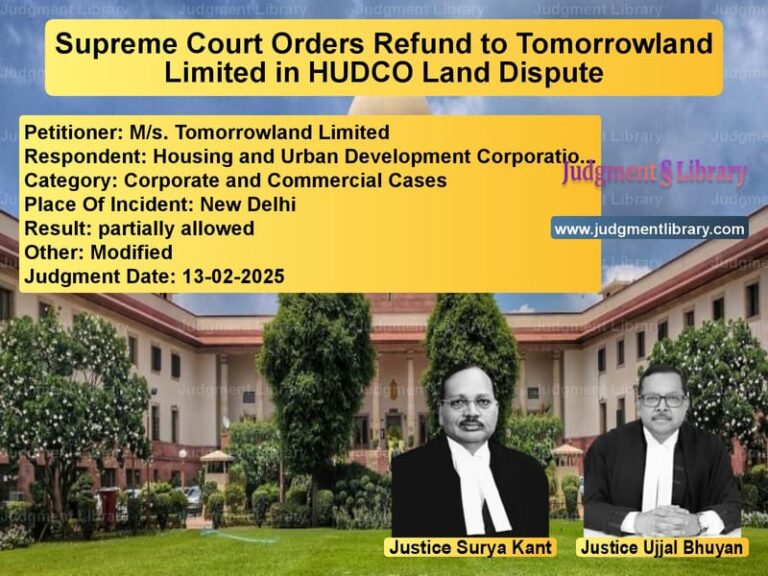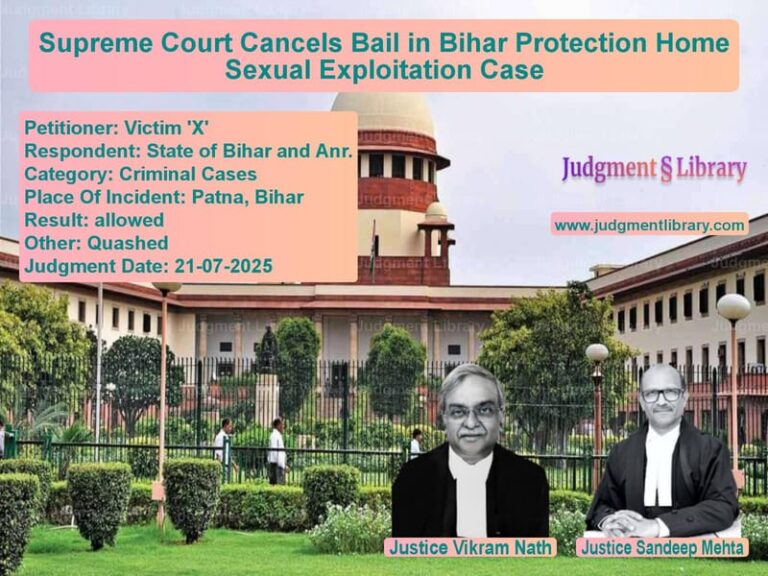Stamp Duty Calculation on Sale Deeds: Supreme Court Clarifies Market Value Determination
The Supreme Court of India, in the case of Shanti Bhushan (D) thr. Lr. & Ors. v. State of U.P. & Ors., clarified the principles governing the determination of market value for stamp duty purposes in property transactions. The case revolved around a dispute regarding the market value of a property purchased through a registered sale deed in Allahabad and the corresponding stamp duty payable.
Background of the Case
The case pertained to a sale deed executed on November 29, 2010, in which the appellants purchased a property measuring 7,818 square meters at Lal Bahadur Shastri Marg (Elgin Road), Allahabad. The appellants contended that they were protected tenants of the property under tenancy laws and had agreed to purchase the property through a compromise decree with the original vendor.
The sale deed was registered, and the appellants paid stamp duty based on a market valuation of Rs. 6,67,200, using the rent capitalization method. However, the Assistant Stamp Collector determined that the market value should be Rs. 19.23 crore, calculating the value at Rs. 24,000 per square meter, leading to a stamp duty demand of Rs. 1.34 crore. A penalty and interest were also imposed.
Petitioner’s Arguments
The appellants, led by Shanti Bhushan, challenged the determination of the market value, arguing:
- They were long-term tenants under rent control laws, which significantly reduced the property’s market value.
- The property was purchased based on an earlier sale agreement from 1966, at the agreed price of Rs. 1 lakh.
- The compromise decree and subsequent sale were conducted legally and should be assessed at the agreed-upon value.
- The rent capitalization method was the correct approach for determining market value in cases of tenanted properties.
- The assessment by the authorities was arbitrary and ignored the realities of the property’s legal status.
Respondent’s Arguments
The State of Uttar Pradesh, through its counsel, countered:
- The stamp duty must be calculated based on prevailing market rates and not historical agreements.
- Rent control laws were irrelevant to determining market value for stamp duty purposes.
- The authorities had relied on comparable sales in 2010 that showed a rate of Rs. 24,000 per square meter.
- The agreement to sell in 1966 had no legal bearing on the 2010 sale deed.
Key Legal Issues Considered
- What is the correct method of determining market value for stamp duty purposes?
- Can historical agreements and rent control laws impact stamp duty calculations?
- Were the penalties and interest imposed on the appellants justified?
Supreme Court’s Observations
The Supreme Court made several key observations:
- “Stamp duty is payable on the market value of the property on the date of execution of the sale deed, not on past agreements.”
- “The valuation under the rent capitalization method does not automatically apply unless proven with clear evidence.”
- “Market value should be determined based on comparable sales of similar properties in the same area.”
- “The High Court erred in upholding the Assistant Stamp Collector’s assessment without properly considering the property’s tenanted nature.”
- “Since the appellants were tenants of the property, the valuation should include a reasonable deduction to reflect the impact of tenancy laws.”
Final Judgment
The Supreme Court ruled:
“The case is remanded to the Assistant Stamp Collector for fresh determination of the market value, considering the impact of tenancy. The penalty is quashed, and interest shall be reconsidered based on the final market valuation.”
Impact of the Judgment
- Clarifies stamp duty calculations: Ensures that valuations consider real market conditions, including tenancy laws.
- Limits arbitrary tax demands: Requires stamp authorities to justify their valuation methods.
- Balances government revenue with taxpayer rights: Prevents excessive taxation based on unrealistic market rates.
Conclusion
The Supreme Court’s ruling in Shanti Bhushan (D) thr. Lr. & Ors. v. State of U.P. provides critical guidance on how market value should be determined for stamp duty purposes. It underscores the importance of considering the property’s tenancy status while ensuring that tax authorities do not impose excessive valuations. This decision strengthens legal clarity for property buyers and ensures fairer taxation in real estate transactions.
Petitioner Name: Shanti Bhushan (D) thr. Lr. & Ors..Respondent Name: State of U.P. & Ors..Judgment By: Justice Abhay S. Oka, Justice Rajesh Bindal.Place Of Incident: Allahabad, Uttar Pradesh.Judgment Date: 25-04-2023.
Don’t miss out on the full details! Download the complete judgment in PDF format below and gain valuable insights instantly!
Download Judgment: shanti-bhushan-(d)-t-vs-state-of-u.p.-&-ors.-supreme-court-of-india-judgment-dated-25-04-2023.pdf
Directly Download Judgment: Directly download this Judgment
See all petitions in Property Disputes
See all petitions in Damages and Compensation
See all petitions in Succession and Wills
See all petitions in Judgment by Abhay S. Oka
See all petitions in Judgment by Rajesh Bindal
See all petitions in Remanded
See all petitions in Remanded
See all petitions in supreme court of India judgments April 2023
See all petitions in 2023 judgments
See all posts in Civil Cases Category
See all allowed petitions in Civil Cases Category
See all Dismissed petitions in Civil Cases Category
See all partially allowed petitions in Civil Cases Category







